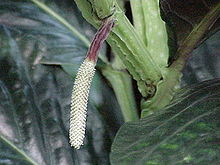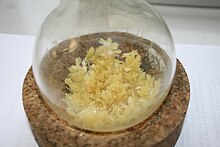Piper (plant)
| Piper Temporal range:
| |
|---|---|

| |
| Lacquered pepper (P. magnificum) inflorescence | |
| Scientific classification | |
| Kingdom: | Plantae |
| Clade: | Tracheophytes |
| Clade: | Angiosperms |
| Clade: | Magnoliids |
| Order: | Piperales |
| Family: | Piperaceae |
| Subfamily: | Piperoideae |
| Genus: | Piper L. |
| Species | |
|
1000–2000; see list | |
| Synonyms | |
| |
Piper, the pepper plants or pepper vines, is an economically and ecologically important genus in the family Piperaceae.
It contains about 1,000–2,000 species of shrubs, herbs, and lianas, many of which are dominant species in their native habitat. The diversification of this taxon is of interest to understanding the evolution of plants.
Pepper plants belong to the
The
Evolution
The earliest fossil of Piper is of †Piper margaritae from the Late Cretaceous (Maastrichtian) of Colombia. P. margaritae appears to be nested within the clade Schilleria, indicating extensive Cretaceous diversification of Piper into the multiple extant clades, coinciding with the final breakup of Gondwana. This contrasts with previous theories assuming a younger radiation of the genus. An earlier potential record is of †Piper arcuatile from the Cenomanian to Santonian Kaltag Formation of Yukon, although this affinity to Piper is not entirely reliable.[1][2][3]
Distribution and ecology
Piper species have a
Most Piper species are either
to pepper growers.Usages
Many pepper plants make good
Unsustainable
The most significant human use of Piper is not for its looks however, but ultimately for the wide range of powerful
As spice and vegetable
Culinary use of pepper plants is attested perhaps as early as 9,000 years ago. Peppercorn remains were found among the food refuse left by Hoabinhian artisans at Spirit Cave, Thailand. It is likely that these plants were collected from the wild rather than deliberately grown.[5][6]

Green (pickled unripe fruits)
White (dried ripe seeds)
Black (dried unripe fruits)
Use of peppercorns as pungent spice is significant on an international scale. By
As Europe moved into the
Due to the wide distribution of Piper, the fruit of other species are also important spices, many of them internationally.
Not only the seeds of Piper are used in cooking. West African Pepper leaves, known locally as uziza, are used as a flavoring vegetable in
As medicine

One Piper species has gained large-scale use as a
Conversely, another Piper species,
In science
The genus contains species suitable for studying

Piper is a model genus for research in ecology and evolutionary biology. The diversity and ecological importance of the genus makes it a strong candidate for ecological and evolutionary studies. Most research has focused on the economically important species P. nigrum (black pepper), P. methysticum (kava), and P. betle (betel). A recent study based on DNA sequence analysis suggest that P. nigrum originated in the Western Ghats hot spot in India.[14]
The obligate and facultative[further explanation needed] ant mutualists found in some Piper species have a strong influence on their biology, making them ideal systems for research on the evolution of symbioses and the effect of mutualisms on biotic communities.[citation needed]
Important secondary metabolites found in pepper plants are piperine and chavicine, which were first isolated from Black Pepper, and reported to have antibiotic activities. Preliminary research reports has shown that piperine has an antibacterial activity against various bacteria such as S. aureus,[15][16] Streptococcus mutans,[17] and gastric cancer pathogen Helicobacter pylori [18] and decreased H. pylori toxin entry to gastric epithelial cells.[19] The piperidine functional group is named after the former, and piperazine (which is not found in P. nigrum in noticeable quantities) was in turn named after piperidine.
The significant secondary metabolites of kava are
Repelling insects
Studies have been done to determine the effectiveness of piper leaves to repel different types of insects.[20]
Capuchin monkeys have been recorded by BBC Earth rubbing the piper leaves on them to repel insects.[21]
Species
The largest number of Piper species are found in the Americas (about 700 species), with about 300 species from Southern Asia. There are smaller groups of species from the South Pacific (about 40 species) and Africa (about 15 species). The American, Asian, and South Pacific groups each appear to be
Some species are sometimes segregated into the genera Pothomorphe, Macropiper, Ottonia, Arctottonia, Sarcorhachis, Trianaeopiper, and Zippelia, but other sources keep them in Piper.[22]
The species called "Piper aggregatum" and "P. fasciculatum" are actually Lacistema aggregatum, a plant from the family Lacistemataceae.
Notes
- ^ Apicius generally uses garum fish sauce instead; raw brine and large quantities of herbs were also employed by many.
References
- ^ PMID 25667080.
- ISSN 2330-7102.
- ^ "Yukok_Koyukuk_2_Geology". clamp.ibcas.ac.cn. Retrieved 2023-06-19.
- International Union for the Conservation of Nature and Natural Resources (IUCN) (2007): 2007 IUCN Red List of Threatened Species Archived 2018-05-08 at the Wayback Machine. IUCN, Gland.
- S2CID 34052655.
- JSTOR 124120.
- ^ Apicius: Cookery and Dining in Imperial Rome. 2009-08-19. Retrieved December 9, 2018.
{{cite book}}:|website=ignored (help) - ^ John Parkinson (1640). Theatrum Botanicum: the Theater of Plants. London: T. Cotes.
- ^ Charmaine Solomon (1998). "Cha plu". Encyclopedia of Asian Food. Periplus Editions.
- ^ "Tropical root crops". Earthcare. 2008. Archived from the original on 19 July 2008. Retrieved 15 July 2008.
- PMID 16904878.
- PMID 17329236.
- ISBN 978-0-306-48498-8.
- S2CID 167218493.
- PMID 16436753.
- PMID 18334493.
- PMID 26870681.
- PMID 25584066.
- PMID 27158376.
- PMID 15384353.
- ^ Monkey Insect Repellent | The Life of Mammals | BBC Earth, retrieved 2023-09-25
- ^ PMID 11302858.
- Sen, Sandeep; Dayanandan, Selvadurai; Davis, Thomson; Ganesan, Rengaian; Jagadish, M.R.; Mathew, P.J.; Ravikanth, Gudasalamani (September 2019). "Origin and evolution of the genus Piper in Peninsular India" (PDF). Molecular Phylogenetics and Evolution. 138: 102–113. S2CID 167218493.
External links
- The families of flowering plants: descriptions, illustrations, identification, information retrieval.
- Piper species in Thailand
